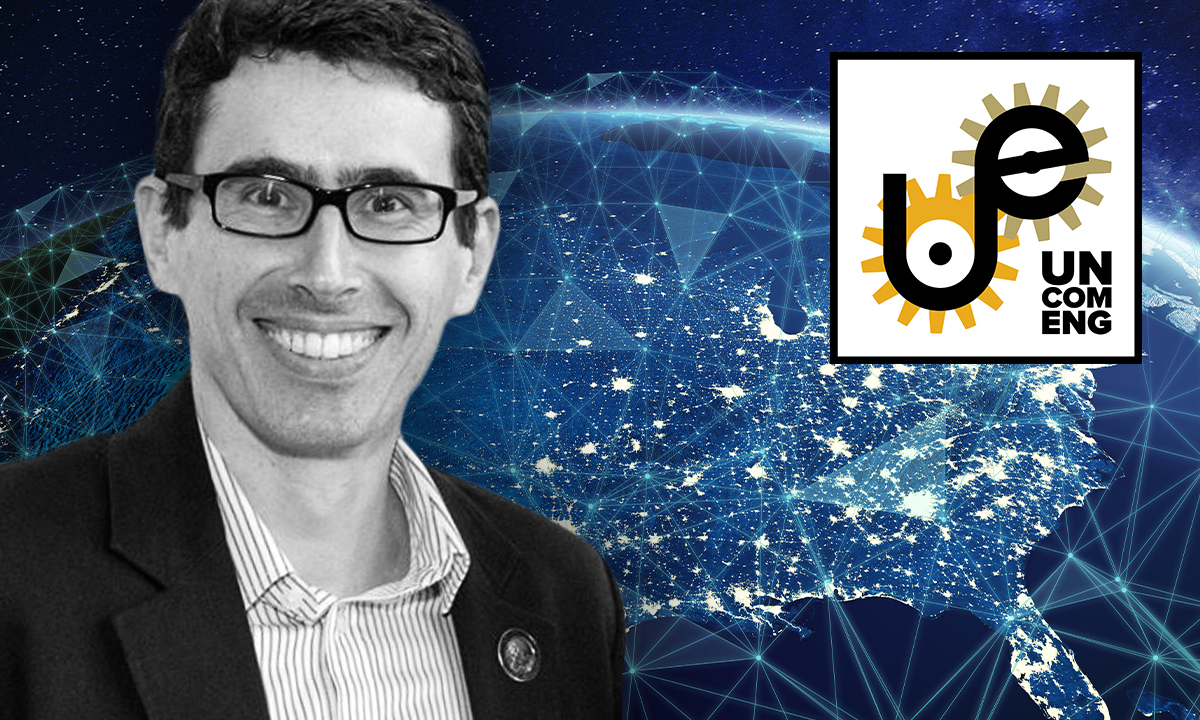
Steve W. McLaughlin

Matthieu Bloch

Audio
Audio & Captions
Transcript
[jazz blues music]
♪ Operator, Atlanta 75322, please. Hurry, operator, please. ♪
Steve McLaughlin: 5G is the next-generation technology standard for cellular networks that promises faster speeds and better connections. As the new global wireless standard, 5G will foster new innovations in connecting people, devices and services together. How does 5G work, and why is the upgrade to 5G so important?
[steam whistle]
[applause]
[marching band music]
♪♪
Steve: This is The Uncommon Engineer.
♪♪
Man: [archival recording] We’re just absolutely pleased as punch to have you with us. Please say a few words.
[applause]
Steve: Our guest today on The Uncommon Engineer podcast is Professor Matthieu Bloch. He's a professor in the School of Electrical and Computer Engineering here at Georgia Tech. His work focuses on the cutting edge of wireless communications and cryptography. Welcome to the show, Matthieu.
Matthieu Bloch: Hey, Steve, great to be here.
Steve: So, you know, anyone who watches any TV or listens to the radio or podcasts has heard about 5G, so maybe the best place to start is what's “5” and what's “G” in terms of wireless?
Matthieu: Yeah, absolutely. so the “5G” really means it's going to be the fifth generation of cellular network standards. And the standards are the set of protocols, the set of technologies that govern how your devices operate when they have to connect to communicate wirelessly. And so perhaps to put things in perspective, it's good to see where is 5G coming from, you know, when was 1st G? When was 2nd G? So, if you don't mind, why don't we take a little tour of history to see where that came from.
[dreamy vibraphone music]
♪♪
Matthieu: So the first G is something that is dated back usually to the late ‘70s, early ‘80s. And what that really describes are the first generation of telecom networks; really the first cell phone that would allow each other to be mobile a little bit and interact, but everything was analog. What that means is that essentially all you are doing is taking your voice, which is a wave, and just putting it onto an electromagnetic wave to go a bit further, but that was essentially what was going on.
And the big revolution started happening for 2G. That's about 10 years later. We're talking about early ‘90s. That's when we started using digital information. So suddenly, instead of just conveying voice, you can convey a little bit of data and message and travels— you know, it can travel a lot further and be reproduced with better quality. It also started to introduce this idea of roaming, meaning that you can start your cellular connection somewhere, walk a little bit further, and you can still have that connection without any break.
And then, you know, if you go forward 10 years again, that's when 3G started to happen. And 3G is really probably what most of us really got to experience first-hand. That's really the first time cellular connections became widespread that everyone started having a cell phone. And if you remember when the first iPhone was introduced— that was, what, 2001, I believe— it was actually not a 3G cell phone. All right, so the technology was there, but it took a few years to really become mainstream.
So if you go fast forward again, 10 years, that's what we're used to right now. That's 4G. And the big difference between 4G and 3G is essentially improvements in quality. So suddenly with 3G, we started using apps on our cell phone, and that requires a lot of data to be transferred, so you need infrastructure to support all that, and that's what 4G was all about.
And, you know, from, as I said, 1G to 2G was a big revolution going from analog to digital. Everything else was really useful, but it's more incremental. That's what we call evolution. Now, 5G promises to be a combination of both. We want to improve upon 4G, meaning we want to go faster, higher data rates, lower latency. But on top of that, 5G is trying to rethink what wireless communications will be used for.
Steve: But I think people still experience 4G as just “my phone in my car moving around,” and 5G seems to contemplate a whole bunch of different scenarios. And maybe that's, number one, do I have that right— I mean, the kinds of use? And then if I have that right, share more about what some of those uses might be.
Matthieu: You're exactly right, Steve. That's exactly where the revolution part of 5G comes in. When I was talking about increased data rates, you're right— it's still having a better cell phone, but it's still a cell phone. Why 5G’s envisioning that goes beyond that is what they call “massive IoT,” which stands for “massive Internet of Things. So let me elaborate on that a little bit to give context and explain what that is. So when people started designing 5G, they did realize that there was potential much beyond you and I chatting over the phone, and so they really articulated that around three ideas. The first one was to say, well, let's keep improving our cell phones. And they call that “enhanced mobile broadband.” And it says higher data rate, better connection. But then they also envisioned what they called “massive machine-type communication.” And what— communications is full of lingo, by the way, that you have to get used to— but what that really envisions is this idea that if you have a really good wireless infrastructure, then you can start connecting everything wirelessly. And we're talking about connecting your fridge, connecting your toaster, connecting cars, connecting, you know, sensors in your garden to monitor whether you have to water your lawn or not. And all that agglomeration of little sensors that you deployed are all interconnected, that's what people call the Internet of Things. But what's different between an Internet of Thing and us is that when we talk, we convey information through voice typically. All these sensors, they get data, and that data has to be sent to processing servers. It has to be interpreted, and so the requirements are very different, and that's why it's called a machine-type communication as opposed to, I guess, a people-type communication.
And to give you an idea of the scale that 5G is envisioning, their goal is to guarantee that you would be able to connect about one million such IoT devices per square kilometer. But that's a density of one less node that is absolutely unprecedented. And as you can imagine, of course, it comes with a lot of technical challenges to solve. And I mentioned three aspects that 5G was pushing on. So I talked about enhanced mobile broadband— that's better cell phones; machine-type communication— that's connecting lots of small devices and sensors; the last one is what they call “ultra-reliable, low-latency communication.” And there, the idea is that it's not enough just to have a lot of bandwidth. It's not enough just to connect a lot of sensors, but you also want to guarantee that you can communicate almost in real-time. And as you can imagine, that's absolutely critical for some applications— and I'm sure we'll get a chance to discuss more of them— but for instance, let's say you want to be able to play video games, right? And you want to do virtual reality video games. It's super important that you get very quick feedback, otherwise you will experience a lag. It will make you, at best, you will lose the game or, at worst, you actually start feeling dizzy. And so this idea that communication has to happen instantly almost, or effectively real-time for the end user, is absolutely critical in 5G. And that's why it is a revolution in the scope of technologies. It's trying to require to achieve a revolution in a whole bunch of applications.
Steve: You know, we're talking, for example, on our conversation right now, we're both in different places. We’re both— we're on this platform, and we're not using 3G or 4G or 5G, you know. I'm connected via Wi-Fi to something in my house that's passing through some kind of a network that's being pulled together. I think you're probably doing the same thing; you're on Wi-Fi. And I think we want to distinguish Wi-Fi, which is I think most people do. Most of the work that they do in their home is on Wi-Fi, and most of the work that they do at work is either direct-connect internet or Wi-Fi. You know, 5G is completely separate from that, and are they envisioning kind of the Wi-Fi world and the 5G world somehow converging?
Matthieu: Oh, that's a great question. I'm not sure I have a really simple answer to that, in part because, you know, technologies and advances are driven not just by us engineers, but also by markets. And sometimes one technology wins for reasons that are not purely technology-driven; it’s just something became more widely available. And just as a little bit of history to point out as to why that's important— when cellular connections became a reality— so we're talking 2G, right— there were two competing formats. One was developed in the U.S. by a company that became Qualcomm in what's called resonant technology called CDMA. It worked extremely well, but the rest of the world adopted something called GSM. And the rest of the world won in a way, just because the technology became more widely adopted. And so, the same thing could happen to Wi-Fi versus 5G. In many ways, if you think about as the end user, both are trying to achieve the same thing. They're trying to make sure that you get a connection anywhere in any room, anywhere you go. I think 5G, because it's coming from the cellular world, is already embracing mobility in a broad sense. You know, you will start your conversation in your own, jump in your car, and finish it at work, whereas Wi-Fi has this concept of hotspots which were already more local, and that's home. But things are likely to converge. And it's for sure the case that 5G is starting to infringe on the territory that used to be dominated by Wi-Fi.
Steve: Because I think it seems like eventually it's inevitable that it will be, let's say, completely transparent to a user. Our phones switch from 5G and Wi-Fi back and forth,
and sometimes don't notice that. We do have control over that sometimes, but whether 5G is the time at which all of that becomes completely transparent to us, I think you're saying it's kind of don't really know yet. It may be, but eventually that will become completely transparent, whether we're in a hotspot and staying in a place or whether we're highly mobile, eventually these will eventually converge and the user will never know the difference.
Matthieu: And you're absolutely right. Things will converge. And hopefully, you know, for the end user, all these things will be fully transparent and will remain affordable. I mean, we can’t quite the economics behind it.
Steve: Can you say more? What are some other applications maybe that people haven’t— that you have thought of, that you are all are working on, but that the public doesn't really appreciate yet?
Matthieu: Yeah, so to be fair in full disclosure, I don't think I, with my research, have been looking specifically at this application that would benefit the public directly. But let me piggyback on what you mentioned about gaming, because there's something really nice about that example that illustrates some of the trade-offs that people have to make right now and what 5G is trying to address.
So one thing that's becoming increasingly popular is what people call “cloud gaming.” And this idea that you can run these extremely computationally hungry games on a server in the cloud that will do all the preprocessing to render great graphics, and because you have a good connection to that cloud server, that information is just pushed to your end device that just has to render the picture without doing all the complex calculations. And right now, that's really hard because, number one, we don't necessarily have these huge, big pipes. And number two, our cell phones are not quite able to do all these calculations without heating up, without draining all the batteries. And so suddenly with 5G, you could really envision playing extremely complex video games on your cell phone without your cell phone heating up, without draining the battery, so I think that's likely to completely change the mobile gaming experience.
But I think— let me give you another application that I think will be enabled by 5G, and that's a bit closer to what I do and that, I think, goes beyond gaming. And let's talk about maybe smart cities for just a second. You might have heard about smart cities. What are smart cities? Well, it's many things, but one of the things it is, is this idea that if we deploy sensors and if we have an infrastructure to exploit the data, we can make more data-driven decisions about how we run a city. And data-driven means from the perspective of the city services, right, better managing traffic, which would be very relevant in Atlanta, better managing water utilities.
But also from the perspective of citizens, it's also a way to be better engaged with your city, like, for instance, information about which public services are accessible with wheelchairs in what places, you know. So taking what we already do right now on the Internet to a completely different level is it would have wide information. And to do that, you need an infrastructure to support all that data. You need to be able to analyze it and make it available. So I think that's one of the cool, more user-centric effect that 5G could have in our daily lives.
Steve: Well, in terms of applications that may emerge under 5G— we talked about gaming; we talked about smart cities— are there other new applications or new ways that wireless communications is going to fit into everyday life?
Matthieu: Oh, yeah, absolutely. And I think that's where 5G really needs to become a revolution. And so let me give you two more examples of applications that would really change our lives. And both of them have to do with the fact that 5G is trying to reduce the latency of networks. So just to be clear, latency refers to the lag that we sometimes experience when we communicate with each other. So 5G is envisioning a 1-millisecond lag for some systems. So to put things in perspective and to talk about the first application— when you're driving, one of the major reasons why we run into accidents is because the time it takes for us to receive a stimulus and react to it and brake, for instance, is about 200 milliseconds. Now, imagine a fleet of cars that are connected through a 5G network that can communicate with the latency of 1 millisecond. What that means is that if your car by itself starts perceiving that you're getting into an obstacle, it can actually automatically initiate the brake at a speed that's unprecedented. So from a safety perspective, 5G is likely to be a key technology to actually enable self-driving cars and networks of self-driving cars.
Another example I can give you has to do with remote surgery. The first remote surgery where a surgeon in New York operated on someone who was located further away— I think that was 2001, so it's pretty old— but it's nowhere close to being a common thing. And again, the key issue there is that if you're a surgeon and you're operating on someone, it's not enough to see something. You actually need to feel something. And the precise term for that is called haptic feedback, like the ability to perceive touch, and that has to happen really quickly. If there is a delay, it is actually confusing. And so, again, with a 5G infrastructure, you can imagine that you can start envisioning these applications where remote surgery becomes a much more common thing because it's going to be safer. It’s going to be more reliable. And that's, I think, where 5G is likely to revolutionize. I think people have identified a few of these vertical industries like Niche, where it's likely to make an impact, but I think there are many others that are likely to pop up that we haven't thought about yet.
Steve: Significantly. So it's all good so far, but I know there are some controversies here and there. Can you talk a little bit about some of the things, whether they're conspiracy theories that need to be debunked or whether there are legitimate concerns about the deployment of 5G?
Matthieu: Absolutely. And, you know, again, full disclosure, I'm not a public health expert and I'm not either an antenna person that does measurements out in the field. So I can convey what I understand of the problem. So I think, I don't know if you remember, but the moment cell phones became ubiquitous and popular the debate started as to whether the electromagnetic waves were harmful or not. And that's a totally legitimate question, and there were a lot of studies. And actually I think there were tens of thousands of studies now that have been made over the years to try to understand that. And two things are important to keep in mind. Number one, this is something that's extremely regulated. Government agencies in the U.S. and Europe, all over the world, have come up with standards that essentially limit the amount of energy that these waves can produce. And we're getting to the point where the energy that we're talking about is much, much less than the energy that your microwave is emitting. So to give you a bit of perspective, you know, people have been very careful about how to set these standards. And number two, across over the past 10 years, I think none of the studies have really been able to demonstrate that there's any harm that's coming out of these waves. You know, not to say that some studies were not a bit more controversial, but in the end, they ended up not being super reproducible. And, you know, in research, reproducibility is absolutely key. So I think it's fair to say that right now the overwhelming consensus is that there are towers, even though they do emit radiation are actually well below what would be considered dangerous for us.
Now, 5G is actually trying to exploit a new part of the wireless spectrum— higher frequencies. And so it's legitimate to ask the same question again. And in particular, if, as we discussed before, we're talking about increasing the density of antennas, there could potentially be an issue. Now, the good news is that the way the protocol has been designed, the density of antennas is increasing, but the power limit is actually going down. So in the end, it should not make any difference for us from a health perspective. But all that being said, there are a lot of studies going on. Of course, there were pre-studies before we even started talking about deploying 5G, but you can be assured that a lot of people are looking at this carefully, and this is being monitored to make sure that indeed we're still learning and making sure that we're not putting anyone in danger.
Steve: What about other maybe unintended or intended uses of such an incredibly powerful technology? Are there are there other things that people are talking about?
Matthieu: Yeah, absolutely. And I think 5G is becoming what people often call the dual-use technology. So to give you an example of a traditional dual-use technology, think about a rocket. You can use that to send astronauts to the International Space Station. You can also use that to carry a nuclear payload. And so these are technologies that could be used for very different purposes. And 5G is actually falling into that category, because if you think about, for instance, what enables real-time video feeds, that opens incredible opportunities for first responders in a critical situation where suddenly you can get situational awareness in real-time, you know where to allocate resources, where to send your first responders. And that's all great, but you can also imagine that now it means that some people might gain access to all the feeds from all the cameras out there and use facial recognition to track people. So that sounds a little bit futuristic, but I can give you a very concrete example that people have thought about and I've tried to actually deal with already. You might have heard that people are deploying more and more smart meters to monitor your utility bills, be it your electricity consumption or your water consumption. And from the perspective of the utility provider, this is great because they get to save money, obviously, because they don't have to dispatch people to read your meter every so often. They get it automatically through the internet. On top of that, they get it with the granularity that they didn't have before. So they can actually understand, you know, your consumption on a much, much, much finer basis. And that sounds all great, but from the perspective of the end user, suddenly what that means is that your utility provider gets to know a lot more about you. And it's not hard to imagine that if you know kind of when I tend to use my washing machine, when I tend to use my AC, you can definitely know when I'm at home and when I'm not at home. And so there are real privacy issues that are linked to this idea of networking everything together. And fortunately, a lot of people have started thinking about it and have started understanding, OK, let's connect things together, but let's also do that in a manner that's privacy-aware. Let's make sure that the user understands what information they're making available, and to some extent, let's make sure that you're not leaking information about something you don't want them to know about. You know, it's probably perfectly fine to have the utility company know how much electricity I consume, but they should not know when I'm home and when I'm not home. And so there are lots of cool things you can do. And we have colleagues in Industrial and Systems Engineering who are extremely good at this, understanding how to ensure privacy when you are able to gather all that data. And right now, I think it's fair to say that 5G is aware of potential security issues, and in that sense is actually doing better than 4G in terms of making sure that unintended people cannot eavesdrop on you too easily, but I think it still leaves a lot of these key issues to the application that is running. So if you are talking about sensor networks, for instance, it is still up to the person running the services that is using that sensor data to maintain privacy. It is not embedded in the protocol that privacy has to be maintained in a way.
And so there are fascinating issues there, some of which I'm working on here, and they're not simple issues because more and more, I think people have to recognize that privacy and security doesn't come for free. There's always a trade-off that you make between how much throughput you can have and how much privacy and security you're going to have. And when you talk about these billions of Internet of Things devices connected together, they're operating on batteries. So you can put a lot of security on them, but suddenly the battery is going to last two months and not 10 years, and so you have to come up with really creative solutions to address these issues. And I think for 6G, that's going to be— there's going to be a discussion for sure. And I don't know that there is any easy solution, but a lot of researchers are looking at that very closely.
Steve: But the natural question then is, what about 6G? Is there going to be such thing as a 6G? Aren't we doing, or haven't we thought of all the possible tricks or all the possible scenarios that eventually we're going to just kind of run out of room, whether it's spectrum, whether it's cell towers, whether it's whatever? So are people starting to talk about 6G, and does this go on forever?
Matthieu: Yeah, that's an awesome question. So the answer is yes, actually. People are starting to envision what is going to be 6G. And I'm actually— there's a workshop organized by the National Science Foundation that's more specific on than what I do, so it's about security issues. It's called NextG Security, right, because people really envision that this incremental generation, that's going to keep going. And the reason it's going to keep going is we're not going to a part where we're going to have less data. We're always going to have more data. We're always going to want to do more with that data. And we moved from— I don't know if you remember, but your first cell phone, you probably can't look at it anymore because the resolution was so bad, right? So we're getting used to these incredible technologies, and we can only move forward. So I think there's going to be a real push to constantly improve, driven in part by economics, driven in part by consumer desires, and to be honest, driven in part because these are cool problems to solve as engineers.
But then your second question was, is there a limit to that? And the answer is yes and no. The reason I think we go from Gs of generations of standards to others is to acknowledge the fact that if you limit yourself to a certain set of technologies— let’s say, let's talk, for instance, about 4G— 4G says you can only communicate in a certain range of the spectrum, then eventually it gets crowded and you have to find something else. So 5G tried to expand on that by opening up a new part of the spectrum. So for 6G, it’s still in really early stages. I mean, I think it would be hard-pressed to tell you what 6G will look like, but there are a couple of hints that things are looking at. One is keep doing what 5G is doing, meaning opening up other portions of the spectrum and communicates on a higher frequency. Of course, it comes with challenges because the distances are going to be smaller and so on, so forth. But the second thing people are looking at right now is somewhat fueled by the undeniable success of machine learning, which is providing new tools to optimize things. One of the key challenges we have in communication networks right now is that, you know, if you and I, Steve, are trying to talk to each other, it's fairly easy for the network to decide “OK, they seem to be having a casual conversation. Let's give them that much bandwidth and it should work.” But if you scale that up to millions of users or billions of users and devices doing that simultaneously, that's a really complicated problem. And that's where machine learning might offer solutions, providing new ways to optimize these networks.
And lastly, people are also envisioning new hardware. People are talking about using what are called metamaterials, which would be coatings that you would put on buildings to help direct your waves where they should be. So there's a lot of excitement going on. Who knows what will really happen, but there's definitely something coming up.
And lastly, maybe the one thing I want to mention is it's important to demystify some of this, right. So the reality is for the public, we use these sketchy words, “4G,” “5G,” “6G,” but the reality is that things are a lot more fluid than this. You might not see it, but there was actually a 2.5G. There was actually 4.5G— it's called LTE. And so the reality is, from the engineering perspective, systems are constantly evolving. And these artificial revolutions, we kind of create them to set milestones, but innovation is constantly happening on all fronts— software, networking, hardware— you name it.
Steve: You know, to point, so I'm hoping that you can share a little bit more about some of the other work, because I know that I think there's a whole bunch of people at Georgia Tech that are working on various pieces of 5G. And then it would also be great to hear about your own lab and some of the work that you're doing in your lab.
Matthieu: Yeah, absolutely. So as you said, you know, we have a great group of people here at Georgia Tech working on telecom. And some of my colleagues, you know, they've had a really high visibility and really strong reputation for decades. They've been really at the forefront of wireless research from when it started. In many ways, I'm a latecomer to the game, but we have a really strong tradition of research in telecom, and that's research that's spanning a whole range of activities. We have people who are experts at designing these incredible circuits that fit on the tiny, tiny square millimeter chip that are actually combining an antenna and an amplifier to receive your signals. We have people who are experts who are designing the algorithms that come and process that information. We have people who work at how to interface optical networks with wireless networks, and then I'm probably forgetting quite a few other cool things that we do. So just to show you that when you talk about telecom, there is a whole breadth of activities that span the hardware, the software. And some of my colleagues are doing awesome work at every stage of that huge ecosystem.
For me personally, I tend to sit more on the theoretical side of things. So if I'm fair, I'm more of a theoretical engineer. That's one thing in the sense that I like to study, maybe not quite the real, real systems where you tweak the knobs and try to really transmit something. But understand, you know, if you think about a communication system as a system, how do you optimize it? What are the high-level principles that you need to put in place to do that? And so a lot of my research tends to answer questions such as, OK, given that you have a 5G network, what is the maximum data rate that actually you can achieve? And it turns out that you have answers to these questions. Given [inaudible] technology, there is a limit on how much bandwidth you can use and how much data rate it translates into for the end user. So these are some of the cool questions that I've been looking at.
And in the context of more 5G problems, we've looked at trying to use machine learning to actually make, to actually make 5G a reality. How do you ensure that you can have this ultra-low-latency systems? Well, it turns out it's hard, and traditional techniques don't quite meet that challenge necessarily, and so we've been exploring new ways to address that.
Steve: It sounds like you have a great interest in theory and mathematics, but you're an electrical engineer, or you're an engineering professor, so how did you get— how did you as a kid, how did you start to get interested in this stuff? We have a lot of listeners that are high school students, junior high school students, and even other Georgia Tech students, and I know that they're almost always curious about how you found— how our guests find their way to engineering.
Matthieu: Well, that's a great point. And I have to admit, I've been extremely lucky personally because in a way— I was born in a family, you know, both my parents are physicists. So, you know, they talked about science at home. My dad used to tinker with things and he would repair stuff. And so as a kid, I was like, yeah, you know, that sounds cool and I want to do that. Then I started tinkering with a soldering iron. I guess maybe when I was 8 or 9, I got one of these little electronics kits, you know, when you connect diodes and you make them blink, and I was just super excited about that stuff. And I like math. I like physics. And, you know, naturally, I think I said, well, you know, you can make a job out of it; that sounds pretty cool to me. And I think one thing I have to say too is I had, you know, along the way, you know, it's important I think if you have a good role models, you know, people who tell you, “Hey, you can do that. You know, you can make a career out of that, and if you like something, go for it!” And I think in that regard, I was super fortunate than most. My parents were good role models. I had awesome teachers all the way from kindergarten to grad school. And it makes a huge difference, I think, to realize that you can become an engineer because you like tinkering with things.
Now, my foray specifically into theory, I have a funny story about that. You might actually know it. I went into grad school thinking I wanted to do medical imaging. That was my thing. In my first semester of grad school, I took a class called Information Theory, I think— there was a professor—
[laughter]
—and information theory is a science behind communication systems. And I was like, wow, that sounds really, really awesome. And the rest is history, I think.
Steve: So full disclosure, I think I'll say it— I know that that professor was me, ha. So we got— I know that's the first place we got to meet was at the Georgia Tech campus in France. Yeah, I remember that class and that experience very, very, very fondly.
I really appreciate your perspective. Thank you so much for coming on. We’re absolutely so incredibly lucky to have people like you at Georgia Tech who do think creatively, who do challenge the status quo because it does result in fantastic things. So Matthieu, thank you so much for coming on The Uncommon Engineer, and really looking forward to seeing you on campus.
Matthieu: Yeah. Thanks for having me, Steve.
[marching band music]
♪♪
Geekout
Audio & Captions
Transcript
[big band swing music]
Steve McLaughlin: How's the infrastructure going to change in 5G? Do they just add more stuff to those existing cell towers or is there going to be a whole different way of deploying cell towers? Are cell towers going to look different than they do now?
Matthieu Bloch: That's an awesome question, and the answer to your question, the short answer is both; you should expect both things will happen. So let me elaborate on that a little bit. So as you said, right now the way we connect to each other through our cell phones is that your cell phone first connects to what's called a base station, and that's a receiver that's on a big antenna. And I think we're used to seeing them. We see them on top of all the buildings these days. If you actually drive along the interstate, you might see that some of them are disguised as trees where they're painted [inaudible] in the neighborhood, but they're absolutely everywhere.
And 5G will actually enhance that a little bit, so you should expect to see more antennas popping up on these big poles. And these antennas will essentially do the job of 4G devices a little bit better. But the big thing that's coming with 5G is what's called the “millimeter wave revolution”. So right now, typically when you transmit your electromagnetic waves are, you know, let's say, in the range of 1 gigahertz. Think about it— that's the typical frequency that you might see when you connect to your Wi-Fi. You might 2.4 gigahertz, 5 gigahertz— that's where you operate. But the way, if you keep doing this, you reach the point where you can’t support a million devices connecting to each other if you stick at these frequencies because you're missing space where everyone can talk to each other. And so 5G decided to actually go much further high in the spectrum, so we're talking about frequencies of tens of gigahertz and above. The way you want to think about it, your microwave, for instance, when it heats up your food, right, it excites water, and the frequency is 1gigahertz. So 5G is envisioning going 10 times beyond that. These are frequencies which are extremely high. They're not quite like optical frequencies, meaning they can still go through buildings, but they start being much shorter distance. But what you benefit is that there's a lot of space there because not many people are using these frequencies right now.
So what's going to change is the following— because you go into these higher frequencies, we will be able to have more bandwidth, and that's really what's going to be driving this huge data rates that I was mentioning before. But at the same time, your electromagnetic waves will only be able to go over shorter distances. And so what we should expect to see is we should expect to see more antennas popping up. So instead of seeing a few of these big antennas per block in the city, we should expect to see smaller antennas popping up on traffic lights, maybe on some road signs, and you'll see an increased density of these antennas. That's a big change that everybody will be able to see already.
You might have heard that some companies, you know, Verizon and AT&T are already advertising 5G, and if you listen to what I said, you’re like, “Well, you know, it's not like I've seen a whole lot of these new antennas pop up, so what's going on?” So what they're doing is they're doing 5G, but they're not quite yet doing the full millimeter wave 5G. I think that's only available in a few select cities. What they're doing is they're improving the existing infrastructure. That's why you don't quite see a change. And as a result you might get a new 5G phone, but don't expect the data rates that I just described. If you buy a 5G phone today, you might get a small improvement on data rates, but it's not going to be that crazy. So that's one thing.
The second thing that I wanted to mention is that there are a lot of regulation issues behind 5G because the standard is there to say this is what you have to do, but then when it comes to deploying antennas, there are a lot of public health issues that you have to consider. You have to decide who owns the pole on which you put the antenna, and it's not clear yet that everyone is on board with that. And it's all for good reasons. I'm not saying that anyone is trying to harm the deployment of 5G, but there's a discussion that needs to go on to make sure that all the stakeholders are OK with the way it's being deployed.
[jazz blues music]
[marching band music]






